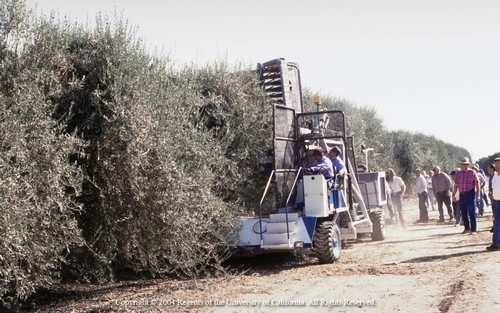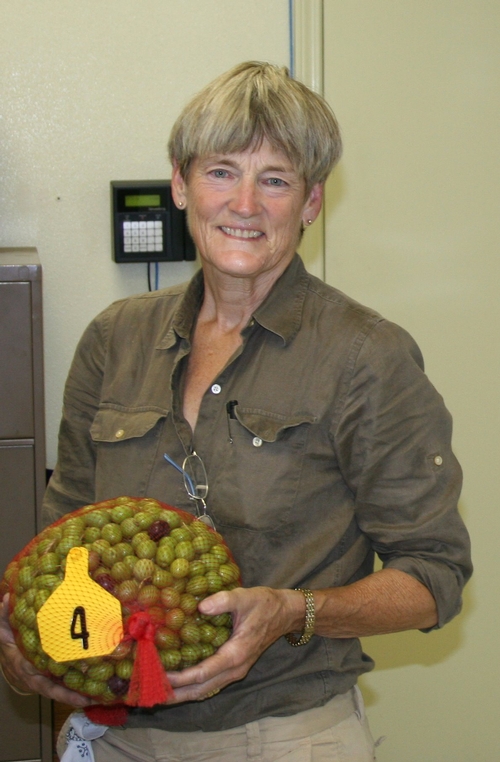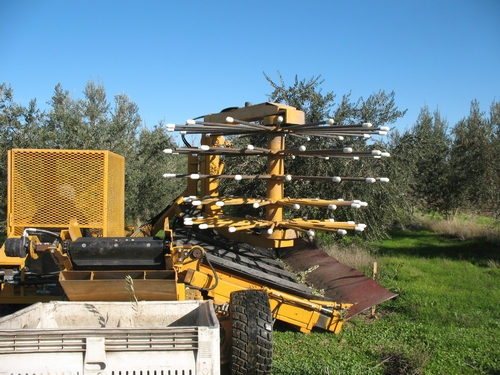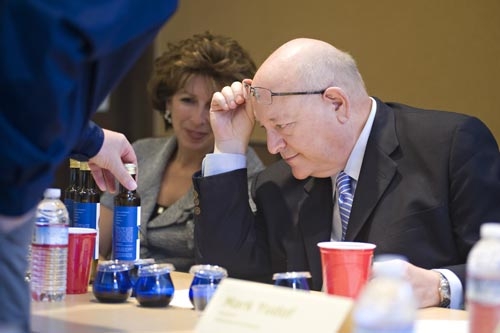Posts Tagged: olives
Keeping olives on the table
Table olives have always been a staple on my family’s fall relish tray so I took notice when I heard this discouraging news: Labor costs are killing the table olive industry. Table olive growers spend more than half of their gross returns on the cost of manually harvesting their crop.
“That’s a ridiculous equation,” says Dennis Burreson of Orland, grower and chairman of the research committee of the California Olive Committee. “We can’t survive if we’re spending more than half our gross returns on labor.”
But here’s the heartening news: With the help of UC Cooperative Extension specialist Louise Ferguson (right) and a large group of collaborators, the industry is doing something about it. They are developing the means to mechanize the devilishly difficult task of picking table olives.
“I think mechanical harvesting will soon revolutionize the table olive industry,” said Ferguson, pomologist with the UC Davis Department of Plant Sciences and director of the UC Davis Fruit & Nut Research and Information Center.
Mechanical harvesters are commonplace for countless commodities, including olive oil olives. What is it about table olives that make them so hard to mechanically pick?
They bruise easily, for one thing, and bruised olives don’t cure well. Plus, table olives are harvested while still immature – unlike the more mature olive oil olives – so it takes more force to knock them off the tree. And then there is the tree canopy: Table olives trees tend to be wispy, less accommodating to mechanical harvesting than the high-density hedgerows you see in olive oil orchards.
Visit a typical table olive orchard and you will see the problem. It’s hard for a mechanical shaker to clean fruit off a tree that just sways, especially when that fruit is hard to dislodge in the first place. Plus, olive tree trunks get knobby with age (like the rest of us). If a machine rubs the bark off those knobs, it opens the tree to disease.
Scientists and engineers have been trying for decades to come up with a viable mechanical harvester. As with earlier attempts, a few versions designed and tested in the mid-90s didn’t pan out because they didn’t remove and capture enough high-quality fruit. But more recent efforts are showing great promise.
The two leading picking technologies are “canopy contact harvesting heads” (it resembles a huge hair brush) and trunk shakers. The canopy contact harvester can be used in existing orchards when they are pruned into a hedgerow and can also be used in the new high-density orchard Ferguson and her team designed, modeled after olive oil orchards. The trunk-shaking technology can be used in new high-density orchards but not in conventional orchards.
And here is the good news on fruit quality, the piece of the puzzle that now makes mechanical harvesting so promising: Even trained testers couldn’t tell the difference between manually and mechanically harvested table olives.
“That’s huge because fruit quality had always been a sticking point,” Ferguson says. “Jean-Xavier Guinard (sensory scientist with the UC Davis Food Science and Technology) worked with an expert panel trained to detect even the slightest defect in texture, taste, aroma – the works. They detected virtually no different between olives that were manually and mechanically harvested.”
More taste tests with both expert and consumer panels are in the works. In the meantime, several growers have decided to take the plunge. Burreson, for example, has planted 120 acres of table olives in the high-density hedgerows Ferguson helped design. In about five years, his olives will be ready for harvest.
So keep your fingers crossed as you enjoy your table olives, figuratively if not literally. It’s hard to keep your fingers crossed if eat them the old-school way, one at a time off each finger and thumb.
President's Blend: Yudof chooses olive oil
Signed, sealed and soon to be delivered: University of California President Mark Yudof’s own blend of olive oil.
UC Davis already has its own popular olive oil, sold in the campus bookstore and online, with customers including Yudof. The self-supporting UC Davis Olive Center – the only academic center of its kind in North America – is looking to branch out with the UC-wide President’s Blend.
A day before Yudof began his tour of high schools to promote access to a UC education, he visited the UC Davis Olive Center on Sept. 30 to give his official seal of approval to the President’s Blend olive oil.
Accompanied by UC Davis Chancellor Linda Katehi and leaders of the campus’ Robert Mondavi Institute for Wine and Food Science, Yudof chose from five blends made with olives grown in California. His favorite? A blend 25 percent Frantoio (Italian) olives and the rest Arbequina (Spanish) olives, the most commonly planted olive in California. Nutty? Yes. Pungent? Check. Bitter? No. Yudof also chose a label design with an image of olives, the UC seal in the middle and the words “President’s Blend.”
“I’m really humbled,” said Yudof, who plans to buy bottles of his blend to send to relatives.
The President’s Blend is expected to be available by the winter holidays. The plan is to sell it at all UC campus bookstores in quarter-liter bottles for $12 apiece.
“We’re hoping we can get out to the other campuses and expose them to really good olive oil,” said Dan Flynn, executive director of the UC Davis Olive Center.
In July, the Olive Center garnered international attention with its study that found many imported olive oils sold in California are not “extra virgin” as their premium labels claim they are. The center is doing a second study to confirm the results, UC Davis professor and sensory scientist Jean-Xavier Guinard said.
The center, part of the Robert Mondavi Institute, collaborates across campus and among producers and the community to promote olive and olive oil research and education. Before testing the olive oil blends, Yudof visited a mobile olive mill, enclosed in a custom-built 38-foot trailer. Olive to Bottle owner Thom Curry brought it for the center’s sold-out course for olive oil producers. “It’s basically like making fruit juice,” Curry said. “The fresher, the better with olive oil.”
Yudof, who also toured the Robert Mondavi Institute’s newly completed, environmentally cutting-edge winery, brewery and food-processing complex, noted the economic promise of California’s growing olive oil industry. California produces almost all olive oil made in the United States, although that amounts to just 1 percent of total domestic consumption in the import-dominated market.
“The olives have the potential to be one of the leading crops in the state, with UC Davis being a leader in the industry, just like with wine and almonds,” Yudof said.
Read more and view a slideshow at Dateline UC Davis.
California table olives - An economic dilemma
How do you use California table olives in your family meals? On pizza? In salads? In Mediterranean dishes? As part of your holiday relish trays?
Today, California is the only U.S. state to commercially produce olives. Over 95 percent of production is canned as California-style black-ripe or green-ripe olives.
California table olive (Olea europaea L.) growers rely on the primary ‘Manzanillo’ cultivar. To assure absolute quality, harvesting is done by hand. Using ladders, crews hand-harvest the olives off each branch, tree by tree. There can be 1,000 olives on a tree, so each crewmember can pick only two or three trees a day. Hand harvesting expenses account for roughly 45 to 60 percent of gross return for growers; and increasing labor costs adversely affect California’s global competitiveness in the table olive market. This is an unsustainable economic situation. California olive growers cannot survive spending more than half their gross incomes on harvest labor.
To help California olive growers deal with this economic dilemma, UC Cooperative Extension specialist Louise Ferguson and her team of research collaborators are focusing on the mechanical harvest of table olives, thus relieving the growers’ total dependency on the costly and shrinking numbers of available hand laborers.
Mechanizing the harvest of table olives presents some unique challenges. The tree canopy and trunk must be adapted to interface with the harvester, avoiding damage to the tree, and the fruit must be collected with minimum bruising. Mechanical harvesting is particularly difficult with table olives. Tree trunk damage, bruised fruit and poor removal efficiency have limited its acceptance.
New technologies have been developed to address these problems: trunk shakers and canopy contact harvesting heads. The most limiting factor, fruit damage, has been eliminated. The trunk shakers can be used in new high-density orchards developed by Ferguson and her team. The canopy harvester can be used in existing orchards if trees are pruned into hedgerows and in the new high-density orchards.
“I think we’ve turned the corner on mechanical harvesting of table olives,” Ferguson says. “And that makes me happy. Table olives are a traditional California crop – they came here with the early Franciscian missionaries. I would hate to see California growers lose their locally-grown advantage in the table olive market. We could actually see a resurgence in the industry.”

Olive trunk shaker

Olive canopy contact harvesting head
California farmers produce superior olive oil
California olive oil may cost a little more than the mass-produced imports commonly found at the supermarket, but UC farm advisor Paul Vossen said it is well worth the money.
“Good olive oil imparts delicious, subtle flavors to foods, its antioxidants can neutralize free radicals in the body and it is ‘greener’ than other vegetable oils because it requires no heat or chemical extraction," says Vossen, who has traveled the world to study olive oil production.
Most of the imported oils found at the store, he says, have been sitting too long, are rancid or fermented. Even the assertion on a bottle of olive oil that it is “extra virgin” means very little. There is no U.S. law that enforces an “extra virgin” standard. Almost all California olive oil, however, is fresher and better-tasting and the number of farmers producing the local oil is increasing.
A recent UC Davis survey determined that 12,127 acres of super-high-density olive trees were planted in California as of the end of 2008, with 78 percent of the acreage planted between 2005 and 2008.
"The super-high-density olive sector has achieved impressive growth in just a decade," said Dan Flynn, executive director of the UC Davis Olive Center. "This survey, the first conducted exclusively of this sector of the state's olive industry, highlights grower practices and suggests areas in which the University of California might be able to provide assistance."
In addition, consumer education is important to raise awareness about the superiority of California olive oil. Vossen believes the key to boosting sales of the local product is to get people to taste it. “They need to know how fantastic it really is,” he said.
In the video below, Vossen conducts an olive oil tasting session:
More about California olive oil is available in the article California olive oil is worth the splurge. Vossen's Web site contains extensive information about olive oil courses, PowerPoint presentations and publications.


![3505 Plate 01 03[1] 3505 Plate 01 03[1]](http://ucanr.org/blogs/food/blogfiles/5202.jpg)



